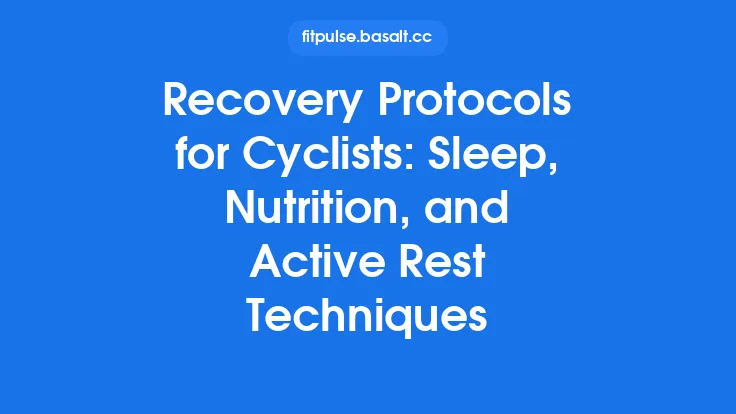Training outdoors offers a unique blend of fresh air, natural lighting, and the ever‑changing terrain of parks and playgrounds that can boost motivation and performance. Yet, the very elements that make outdoor calisthenics appealing—variable weather, uneven surfaces, and the need to transport equipment—also place distinct demands on the body. Optimizing recovery becomes essential not only for maintaining progress but also for preventing fatigue, injury, and burnout. Below is a comprehensive guide to the three pillars of recovery—nutrition, hydration, and rest—tailored specifically for athletes who practice bodyweight and calisthenics in open‑air environments.
Nutrition: Fueling Repair and Adaptation
1. Macronutrient Balance for Bodyweight Athletes
- Protein (1.4–2.0 g/kg body weight)
Protein supplies the amino acids required for muscle protein synthesis (MPS). After a demanding session of pull‑ups, dips, and plyometric jumps, aim to consume 20–30 g of high‑quality protein within 30–60 minutes. Sources that travel well to the park include whey or plant‑based protein powders, roasted chickpeas, jerky, or a hard‑boiled egg.
- Carbohydrates (3–5 g/kg body weight)
Glycogen stores are the primary energy reservoir for high‑intensity calisthenics. Complex carbs (whole grain wraps, oats, quinoa salads) should be the backbone of pre‑workout meals, while simple carbs (fruit, honey, sports gels) are useful immediately post‑session to accelerate glycogen replenishment.
- Fats (0.8–1.0 g/kg body weight)
Healthy fats support hormone production (including testosterone and cortisol regulation) and provide a sustained energy source for longer, low‑intensity park sessions. Avocado, nuts, seeds, and olive oil are portable options that can be added to post‑workout smoothies or snack packs.
2. Micronutrients Critical for Outdoor Training
- Vitamin D – Sun exposure is abundant outdoors, but depending on latitude, season, and skin coverage, synthesis may still be insufficient. A daily supplement of 1,000–2,000 IU can help maintain optimal bone health and immune function.
- Magnesium – Essential for muscle relaxation and electrolyte balance. Include magnesium‑rich foods such as leafy greens, pumpkin seeds, and dark chocolate, or consider a 200–400 mg magnesium citrate supplement after training.
- Vitamin C & E – Antioxidants that mitigate oxidative stress from UV radiation and intense effort. Citrus fruits, berries, nuts, and seeds are convenient park‑friendly choices.
3. Timing Strategies
| Phase | What to Eat | Why |
|---|---|---|
| Pre‑Workout (2–3 h before) | Balanced meal: whole grain toast + nut butter + banana; or oatmeal with berries and Greek yogurt | Provides sustained glucose, spares muscle glycogen, and primes protein synthesis. |
| During (if >90 min) | Small carb snack: dried fruit, energy bar, or sports drink (≈30 g carbs) | Maintains blood glucose and delays fatigue. |
| Post‑Workout (0–60 min) | Protein‑carb combo: whey shake with a piece of fruit; or turkey wrap with lettuce and a drizzle of olive oil | Maximizes MPS, restores glycogen, and initiates recovery pathways. |
| Evening | Light protein (cottage cheese, casein shake) + complex carbs (sweet potato) | Supports overnight repair without overloading the digestive system. |
4. Practical Packing Tips for the Park
- Reusable containers: Portion meals into BPA‑free containers the night before.
- Compact protein powders: A single‑serve sachet eliminates the need for a shaker bottle.
- Hydration packs: A small CamelBak or insulated bottle with a built‑in straw encourages frequent sipping without interrupting flow.
Hydration: Managing Fluid Balance in Variable Conditions
1. Understanding Sweat Loss
Outdoor calisthenics can produce sweat rates ranging from 0.5 L/h in cool, breezy conditions to over 2 L/h on hot, humid days. Sweat not only removes water but also electrolytes—primarily sodium, potassium, calcium, and magnesium. Failure to replace these can lead to cramping, decreased neuromuscular performance, and impaired recovery.
2. Fluid Intake Guidelines
- Baseline: Aim for 35–45 mL of water per kilogram of body weight per day (e.g., a 70 kg athlete needs ~2.5–3 L).
- Pre‑Exercise: Drink 500 mL of water or a low‑calorie electrolyte beverage 2–3 hours before the session.
- During Exercise: Consume 150–250 mL every 15–20 minutes. In hot weather, add 200–300 mg of sodium per liter of fluid (e.g., a sports drink or a pinch of salt in water).
- Post‑Exercise: Replace 150% of the fluid lost. Weigh yourself before and after the session; each kilogram of weight loss ≈ 1 L of fluid. For example, a 0.8 kg loss requires 1.2 L of rehydration fluid.
3. Electrolyte Strategies
- Sodium: The most critical for fluid retention. Use electrolyte tablets (200–300 mg Na⁺ per tablet) or a pinch of sea salt in water.
- Potassium: Bananas, dried apricots, or a potassium‑rich sports drink help prevent muscle cramps.
- Magnesium & Calcium: Include a balanced electrolyte powder that supplies 30–50 mg of magnesium and 100–150 mg of calcium per serving.
4. Temperature‑Specific Adjustments
| Condition | Fluid Recommendation | Additional Tips |
|---|---|---|
| Cool (<15 °C) | 150 mL/15 min, primarily water | Focus on overall daily intake; sweat loss is lower. |
| Warm (15–25 °C) | 200 mL/15 min, water + 200 mg Na⁺ | Use a lightly flavored electrolyte drink to encourage consumption. |
| Hot (>25 °C) & Humid | 250–300 mL/15 min, electrolyte‑rich fluid | Pre‑cool with ice‑slurry drinks (½ L water + ½ L ice) 30 min before training. |
5. Practical Hydration Gear for the Outdoors
- Insulated bottles: Keep fluids cool for longer, reducing the temptation to skip drinking.
- Collapsible water bladders: Fit into a backpack without adding bulk.
- Portable electrolyte packets: Single‑serve sachets that dissolve in any water source.
Rest & Recovery: Maximizing Adaptation Between Sessions
1. Sleep: The Cornerstone of Regeneration
- Quantity: 7–9 hours per night for most adults; elite calisthenics athletes may benefit from 9–10 hours during high‑volume training phases.
- Quality: Aim for a sleep efficiency >85% (time asleep ÷ time in bed). Dark, quiet, and cool environments (≈18 °C) promote deeper REM and slow‑wave sleep, which are crucial for hormonal balance and tissue repair.
- Napping: A 20–30 minute nap in the early afternoon can improve alertness and reduce perceived fatigue without disrupting nighttime sleep.
2. Active Recovery Techniques
- Low‑Intensity Mobility Work: 10–15 minutes of dynamic stretching, foam rolling, or yoga poses (e.g., cat‑cow, child's pose) after a session helps flush metabolic waste and maintain joint range of motion.
- Contrast Showers: Alternating 1 minute of hot water (38–40 °C) with 30 seconds of cold water (10–12 °C) for 5–6 cycles stimulates vasodilation and vasoconstriction, enhancing circulation and reducing delayed‑onset muscle soreness (DOMS).
- Light Aerobic Activity: A 20‑minute brisk walk or easy bike ride the day after a heavy park workout promotes blood flow without adding mechanical stress.
3. Periodization of Rest Days
- Micro‑Cycles: In a typical 7‑day micro‑cycle, schedule 1–2 full rest days and 1–2 active‑recovery days.
- Deload Weeks: Every 4–6 weeks, reduce volume by 40–60% while maintaining intensity to allow connective tissue remodeling.
- Monitoring Tools: Use a simple wellness questionnaire (sleep quality, muscle soreness, mood) and a heart‑rate variability (HRV) app to gauge readiness. A drop of >10% in HRV from baseline may signal the need for additional rest.
4. Environmental Considerations for Outdoor Rest
- Shade & Shelter: After a hot session, find a shaded area or a portable canopy to cool down gradually, preventing a sudden drop in core temperature that can cause stiffness.
- Ground Surface: When performing post‑workout mobility on grass or a rubber mat, ensure the surface is clean and free of debris to avoid skin irritation.
- Air Quality: On days with high pollen or pollution, consider indoor recovery (e.g., stretching in a well‑ventilated room) to protect respiratory health.
5. Supplementary Recovery Aids (Optional)
| Supplement | Typical Dose | Evidence for Outdoor Calisthenics |
|---|---|---|
| Creatine Monohydrate | 3–5 g daily | Improves phosphocreatine stores, aiding repeated high‑intensity efforts like explosive pull‑ups. |
| Omega‑3 Fatty Acids | 1–2 g EPA/DHA | Anti‑inflammatory properties reduce DOMS and support joint health. |
| Tart Cherry Juice | 240 mL (≈30 mL concentrate) | Contains anthocyanins that may attenuate muscle soreness after eccentric training. |
| L‑Glutamine | 5–10 g post‑workout | May support immune function during heavy training blocks, though evidence is mixed. |
Integrating Recovery Into a Real‑World Outdoor Routine
- Pre‑Session Checklist
- Hydrate (500 mL water + electrolytes) 2 hours before.
- Eat a balanced meal 2–3 hours prior.
- Pack a lightweight recovery kit (protein powder, electrolyte sachets, towel, portable foam roller).
- During the Session
- Sip fluid every 15 minutes.
- Take brief 30‑second “micro‑breaks” after high‑intensity sets to perform a quick stretch or deep‑breathing exercise, which also aids mental focus.
- Post‑Session Protocol
- Within 30 minutes: consume a protein‑carb shake (≈25 g protein, 40 g carbs).
- Rehydrate according to sweat loss calculations.
- Perform 10 minutes of mobility work on a portable mat.
- Cool down in shade, then transition to a recovery snack (e.g., Greek yogurt with honey and nuts).
- Evening Routine
- Light dinner rich in protein and complex carbs, with a serving of vegetables for micronutrients.
- Limit screen exposure 1 hour before bed; consider a short meditation to lower cortisol.
- Ensure the sleeping area is cool, dark, and quiet.
Frequently Asked Questions
Q: How much protein should I consume on a rest day?
A: Maintain your daily target (1.4–2.0 g/kg) even on rest days to support ongoing repair. Distribute intake evenly across meals (≈0.3 g/kg per meal).
Q: Is it okay to drink only water if I’m training in mild weather?
A: For sessions under 60 minutes in moderate temperatures, water alone is usually sufficient. However, adding a pinch of salt or a low‑calorie electrolyte tablet can improve fluid retention.
Q: Can I skip a full rest day if I feel good?
A: While subjective feeling is important, objective markers like HRV, sleep quality, and cumulative training load should guide decisions. Consistently training without full rest can lead to overreaching and increased injury risk.
Q: What’s the best way to carry food to the park without attracting insects?
A: Use airtight containers, keep foods cool in an insulated bag, and avoid sugary liquids that can spill. Packing meals in silicone or stainless‑steel containers reduces odor and leakage.
Bottom Line
Recovery for outdoor calisthenics is a multidimensional process that intertwines proper nutrition, strategic hydration, and intentional rest. By tailoring macronutrient timing, electrolyte balance, and sleep hygiene to the unique challenges of training in parks and open spaces, athletes can accelerate adaptation, preserve joint health, and sustain long‑term performance. Implement the practical tips and structured protocols outlined above, and you’ll turn every park session into a stepping stone toward stronger, more resilient bodyweight mastery.





